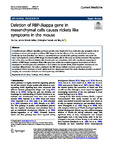Deletion of RBP-Jkappa gene in mesenchymal cells causes rickets like symptoms in the mouse
| dc.contributor.author | Gao, Y | |
| dc.contributor.author | Walker, JV | |
| dc.contributor.author | Tredwin, Christopher | |
| dc.contributor.author | Hu, Bing | |
| dc.date.accessioned | 2022-06-28T12:39:59Z | |
| dc.date.issued | 2022-05-26 | |
| dc.identifier.issn | 2731-0868 | |
| dc.identifier.issn | 2731-0868 | |
| dc.identifier.other | 7 | |
| dc.identifier.uri | http://hdl.handle.net/10026.1/19353 | |
| dc.description.abstract |
<jats:title>Abstract</jats:title><jats:p>Crosstalk between different signalling pathways provide deep insights for how molecules play synergistic roles in developmental and pathological conditions. RBP-Jkappa is the key effector of the canonical Notch pathway. Previously we have identified that Wnt5a, a conventional non-canonical Wnt pathway member, was under the direct transcriptional control of RBP-Jkappa in dermal papilla cells. In this study we further extended this regulation axis to the other two kind of skeletal cells: chondrocytes and osteoblasts. Mice with conditional mesenchymal deletion of RBP-Jkappa developed Rickets like symptoms. Molecular analysis suggested local defects of Wnt5a expression in chondrocytes and osteoblasts at both mRNA and protein levels, which impeded chondrocyte and osteoblast differentiation. The defects existing in the RBP-Jkappa deficient mutants could be rescued by recombinant Wnt5a treatment at both cellular level and tissue/organ level. Our results therefore provide a model of studying the connection of Notch and Wnt5a pathways with Rickets.</jats:p> | |
| dc.format.extent | 7- | |
| dc.format.medium | Print-Electronic | |
| dc.language | en | |
| dc.language.iso | eng | |
| dc.publisher | Springer Science and Business Media LLC | |
| dc.subject | Bone | |
| dc.subject | Cartilage | |
| dc.subject | Notch | |
| dc.subject | Rickets | |
| dc.subject | Wnt5a | |
| dc.title | Deletion of RBP-Jkappa gene in mesenchymal cells causes rickets like symptoms in the mouse | |
| dc.type | journal-article | |
| dc.type | Journal Article | |
| plymouth.author-url | https://www.ncbi.nlm.nih.gov/pubmed/35694720 | |
| plymouth.issue | 1 | |
| plymouth.volume | 1 | |
| plymouth.publication-status | Published | |
| plymouth.journal | Current Medicine | |
| dc.identifier.doi | 10.1007/s44194-022-00007-w | |
| plymouth.organisational-group | /Plymouth | |
| plymouth.organisational-group | /Plymouth/Faculty of Health | |
| plymouth.organisational-group | /Plymouth/Faculty of Health/Peninsula Dental School | |
| plymouth.organisational-group | /Plymouth/REF 2021 Researchers by UoA | |
| plymouth.organisational-group | /Plymouth/REF 2021 Researchers by UoA/UoA03 Allied Health Professions, Dentistry, Nursing and Pharmacy | |
| plymouth.organisational-group | /Plymouth/Research Groups | |
| plymouth.organisational-group | /Plymouth/Research Groups/Institute of Translational and Stratified Medicine (ITSMED) | |
| plymouth.organisational-group | /Plymouth/Research Groups/Institute of Translational and Stratified Medicine (ITSMED)/CBR | |
| plymouth.organisational-group | /Plymouth/Users by role | |
| plymouth.organisational-group | /Plymouth/Users by role/Academics | |
| plymouth.organisational-group | /Plymouth/Users by role/Researchers in ResearchFish submission | |
| dc.publisher.place | Switzerland | |
| dcterms.dateAccepted | 2022-04-26 | |
| dc.rights.embargodate | 2022-6-29 | |
| dc.identifier.eissn | 2731-0868 | |
| dc.rights.embargoperiod | Not known | |
| rioxxterms.versionofrecord | 10.1007/s44194-022-00007-w | |
| rioxxterms.licenseref.uri | http://www.rioxx.net/licenses/all-rights-reserved | |
| rioxxterms.licenseref.startdate | 2022 | |
| rioxxterms.type | Journal Article/Review | |
| plymouth.funder | Role of the FoxN1 gene as a central regulator of epidermal planar cell polarity signaling expression and function::BBSRC |


